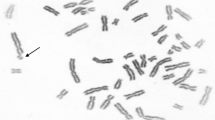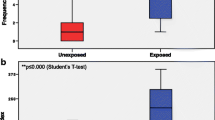Abstract
An intervention study was performed on 28 workers exposed by inhalation to styrene in the reinforced plastics industry and 20 controls not occupationally exposed to the compound. The workers involved were 14 laminators exposed to a time-weighted average of approximately 40 ppm styrene and 14 formers exposed to an average of about 10 ppm styrene. Ambient air monitoring data and the concentration of mandelic acid in the urine were used for the assessment of exposure. From each subject, peripheral blood lymphocytes were analysed for sister chromatid exchanges (SCEs). In the laminators, the mean SCE frequency was significantly higher than in the controls in both the group of smokers (9.59 ± 0.77 SCEs/cell vs 7.23 ± 1.00 SCEs/cell) and the group of non-smokers (10.25 ± 1.08 SCEs/cell vs 5.98 ± 0.60 SCEs/cell). The mean SCE frequency of the formers (7.42 ± 128 SCEs/cell in smokers) did not differ statistically from the controls (7.23 ± 1.00 SCEs/cell in smokers). No evaluation was made for non-smoking formers since all but one worker in this group were smokers. In order to comply with a lowering of the occupational exposure limit (MAK value) for occupational exposure to styrene in the Federal Republic of Germany from 100 ppm to 20 ppm, considerable technical and hygienic improvements were made at the work site of the laminators. This intervention led to a reduction of average exposure of these workers by inhalation from 40 ppm to approximately 20 ppm. One year after these improvements were made, a second investigation was performed. In all but one of the laminators, the concentration of mandelic acid in urine had dropped considerably. The SCE frequency in blood lymphocytes of the laminators had likewise dropped significantly to 7.74 ± 0.59 SCEs/cell in the non-smokers. In the smokers, it was also lower than on the first occasion (9.02 ± 1.19), yet statistical evaluation was not possible due to insufficient numbers. Overall, the results of the intervention study show that the lowering of the occupational exposure limit for styrene to 20 ppm in Germany was justified and that a reduction of occupational exposure to the chemical has led to a prevention of adverse cytogenetic effects.
Similar content being viewed by others
References
Andersson HC, Tranberg EA, Uggla AH, Zetterburg G (1980) Chromosomal aberrations and sister-chromatid exchanges in lymphocytes of men occupationally exposed to styrene in a plastic-boat factory. Mutat Res 73:387–401
Bender MA, Preston RJ, Leonard RC, Pyatt BE, Gooch PC, Shelby MD (1988) Chromosomal aberration and sister-chromatid exchange frequencies in peripheral blood lymphocytes of a large human population sample. Mutat Res 204:421–433
Bond JA (1989) Review of the toxicology of styrene. CRC Crit Rev Toxicol 19:227–249
Brenner DD, Jeffrey AM, Latriano L, Wazneh L, Warburton D, Toor M, Pero RW, Andrews LR, Walles S, Perera FP (1991) Biomarkers in styrene-exposed boatbuilders. Mutat Res 261:225–236
Brooks SM, Anderson L, Emmett E, Carson A, Tsay JY, Elia V, Buncher R, Karbowsky R (1980) The effects of protective equipment on styrene exposure in workers in the reinforced plastics industry. Arch Environ Health 35:287–294
Byfält Nordqvist M, Löf A, Osterman-Golkar S, Walles SAS (1985) Covalent binding of styrene and styrene-7,8-oxide to plasma proteins, hemoglobin and DNA in the mouse. Chem Biol Interact 55:63–73
Camurri L, Codeluppi S, Pedroni C, Scarduelli L (1983) Chromosomal aberrations and sister-chromatid exchanges in workers exposed to styrene. Mutat Res 119:361–369
CEC, Commission of the European Communities (1990) Styrene. In: Berlin A, Draper M, Krug E, Roi R, Van der Venne MT (eds) The toxicology of chemicals. I. Carcinogenicity, vol. II. Summary reviews of the scientific evidence. Office for Official Publications of the European Communities, Luxembourg, pp 93–102
Das BC, Ram R, Mitra AB, Luthra UK (1985) Baseline frequency of sister-chromatid exchanges (SCE) in newborn lymphocytes and its relationship to in vivo aging in humans. Mutat Res 144:85–88
DFG, Deutsche Forschungsgemeinschaft (1987) MAK- and BAT-Werte-Liste 1987. In: Henschler D (ed) Senatskommission zur Prüfung Gesundheitsschädlicher Arbeitsstoffe. VCH Verlagsgesellschaft, Weinheim
DFG, Deutsche Forschungsgemeinschaft (1993) Analytische Methoden zur Prüfung gesundheitsschädlicher Arbeitsstoffe; Luftanalysen. In: Henschler D (ed) Senatskommission zur Prüfung Gesundheitsschädlicher Arbeitsstoffe. VCH Verlagsgesellschaft, Weinheim
Goergens HW (1993) Stereochemische Aspekte bei der biologischen Überwachung beruflicher Styrolexposition. Thesis, University of the Saarland, Medical Faculty, Homburg/Saar
Guillemin MP, Berode M (1988) Biological monitoring of styrene: a review. Am Ind Hyg Assoc J 49:497–505
Hansteen IL, Jelmert O, Torgrinsen T, Forsund B (1984) Low human exposure to styrene in relation to chromosome breaks, gaps and sister chromatid exchanges. Hereditas 100:87–90
Husum B, Wulf HC, Niebuhr E (1986) Sister chromatid exchange frequency correlates with age, sex and cigarette smoking in a 5year material of 553 healthy adults. Hereditas 105:17–21
Jantunen K, Mäki-Paakkanen J, Norppa H (1986) Induction of chromosome aberrations by styrene and vinylacetate in cultured human lymphocytes: dependence on erythrocytes. Mutat Res 159:109–116
Meretoja T, Järventaus H, Sorsa M, Vainio H (1978) Chromosome aberrations in lymphocytes of workers exposed to styrene. Scand J Work Environ Health 4 (Suppl 2):259–264
Norppa H, Sorsa M, Pfäffli P, Vainio H (1980) Styrene and styrene oxide induce SCEs and are metabolised in human lymphocyte cultures. Carcinogenesis 1:357–361
Norppa H, Vainio H, Sorsa M (1983) Metabolic activation of styrene by erythocytes detected as increased sister chromatid exchanges in cultured human lymphocytes. Cancer Res 43:3579–3582
Perera F, Mayer J, Jaretzki A, Hearne S, Brenner D, Young TL, Fischman HK, Grimes M, Grantham S, Tang MX, Tsai WY, Santella RM (1989) Comparison of DNA adducts and sister chromatid exchange in lung cancer cases and controls. Cancer Res 49:4446–4451
Perry P, Wolff S (1974) New Giemsa method for the differential staining of sister chromatids. Nature 251:156–158
Sardas S, Gök S, Karakaya AE (1991) Increased frequency of sister chromatid exchanges in the peripheral lymphocytes of cigarette smokers. Toxic In Vitro 5:263–265
Tucker JD, Auletta A, Cimino MC, Dearfield KL, Jacobson-Kram D, Tice RR, Carrano AV (1993) Sister-chromatid exchange: second report of the Gene-Tox program. Mutat Res 297:101–180
Watanabe T, Endo A, Sato K, Ohtsuki T, Miyasaka M, Koizumi A, Ikeda M (1981) Mutagenic potential of styrene in man. Ind Health 19:37–45
Yager JW, Paradisin WM, Rappaport SM (1993) Sister-chromatid exchanges in lymphocytes are increased in relation to longitudinally measured occupational exposure to low concentrations of styrene. Mutat Res 319:155–165
Author information
Authors and Affiliations
Rights and permissions
About this article
Cite this article
Hallier, E., Goergens, H.W., Hallier, K. et al. Intervention study on the influence of reduction of occupational exposure to styrene on sister chromatid exchanges in lymphocytes. Int Arch Occup Environ Health 66, 167–172 (1994). https://doi.org/10.1007/BF00380775
Received:
Accepted:
Issue Date:
DOI: https://doi.org/10.1007/BF00380775




